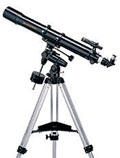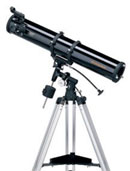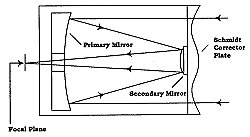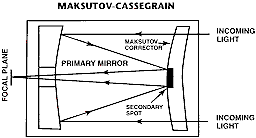|
key features every new backyard astronomer
should know
purchasing
a new telescope can be very confusing. it's almost like you need to learn
another language to understand all the various types of telescopes and
accessories. choosing the right telescope for you depends on your individual
needs including cost, portability, versatility, usability, appearance,
etc.
before we jump into the different types of telescopes here are some important
ground rules to be aware of. knowing these tips will help you better understand
the different types of telescopes and help you choose what is best for
you.
first things first
– a word about magnification. magnification or “power” is the least
important factor when choosing a telescope. the single greatest misconception
about telescopes is that you need to have lots of magnification to see
objects. it is the telescopes light gathering ability, referred to as
aperture that will determine how much you can see. be cautious
of outrageous claims of 500x or 600x magnification on inexpensive telescopes
– these often department-store brand telescopes, are taking advantage
of the number one falsehood in telescopes – that magnification is everything.
aperture – bigger is better…sometimes.
the most important specification
on a telescope is its aperture. aperture is the size of the telescopes
light gathering lens or mirror. that lens or mirror is often referred
to as the telescopes objective. aperture is usually measured in
millimeters or inches. it is aperture that will determine how much light
gathering power the telescope will have. the telescopes ability to gather
light is what will determine how well you will be able to view objects.
ok. so a
telescopes ability to gather light is the most important thing. so i should
look for the largest telescope? not necessarily. you don't want to forget
about portability. what good is a monster telescope if you never want
to lug it around? you will need to ask yourself “where will i want
to use my new telescope?” if the answer is nearby in the backyard
then having a large telescope will be of great advantage to you. if you
need to bring the telescope to darker skies away from city lights – will
you be able to handle the size and weight of a large telescope? it is
often overlooked that you will have to assemble and set up your telescope
in the dark making it even more challenging. avoid the thought of just
getting the biggest scope you can get. you will have little enjoyment
of your new telescope if it sits in the attic because every time you think
about using it you cringe at the though of moving it.
your first major decision – what type of telescope? refractors
– reflectors and catadioptrics
there are three basic types of telescopes – refractors, reflectors, and
catadioptrics. all these designs have the same purpose, to collect light
and bring it to a point of focus so it can be magnified and examined with
an eyepiece, but each does it differently. below we will discuss the most
popular types of telescopes and describe advantages and disadvantages
of each.
[top of page]
refractor
refractors are what the average person identifies with the word “telescope”,
a long, thin tube where light passes in a straight line from the front
objective lens directly to the eyepiece at the opposite end of the tube.


advantages
» easy to use and reliable
due to the simplicity of design.
» little or no maintenance
» excellent for lunar, planetary and binary star observing especially
in larger apertures
» good for distant terrestrial viewing
» high contrast images with no secondary mirror or diagonal obstruction
» color correction is good in achromatic designs and excellent in apochromatic,
fluorite and ed designs
» sealed optical tube reduces image degrading air currents and protects
optics
» objective lens is permanently mounted and aligned
disadvantages
»
more expensive per inch of aperture than
reflectors or catadioptrics
» heavier, longer and bulkier than equivalent aperture reflectors and
catadioptrics
» the cost and bulk factors limit the practical useful maximum size objective
to small apertures
» less suited for viewing small and faint deep sky objects such as distant
galaxies and nebulae because of practical aperture limitations
[top of page]
reflector
reflectors usually use a concave
parabolic primary mirror to collect and focus incoming light onto a flat
secondary mirror that in turn reflects the image out of an opening at
the side of the main tube and into the eyepiece.


advantages
» lowest cost per inch of aperture compared to refractors and catadioptrics
since mirrors can be produced at less cost than lenses in refractors in
medium to large apertures.
» reasonably compact and portable
» excellent for faint deep sky objects such as remote galaxies, nebulae
and star clusters because of their larger apertures for light gathering.
» low in optical aberrations and deliver very bright images
disadvantages
» generally not suited for terrestrial applications
» slight light loss due to secondary obstruction when compared with refractors
[top of page]
catadioptrics
catadioptrics use a combination
of mirrors and lenses to fold the optics and form an image. there are
two popular designs: the schmidt-cassegrain and the maksutov-cassegrain.
in the schmidt-cassegrain the light enters through a thin aspheric schmidt
correcting lens, then strikes the spherical primary mirror and is reflected
back up the tube and intercepted by a small secondary mirror which reflects
the light out an opening in the rear of the instrument where the image
is formed at the eyepiece. catadioptrics are the most popular type of
instrument, with the most modern design, marketed throughout the world
in 3 ½” and larger apertures.


schmidt-cassegrain advantages
» best all around, all purpose
telescope design. combines the optical advantages of both lenses and mirror
while canceling their disadvantages.
» excellent optics with razor sharp images over a wide field
» excellent for deep sky observing or astrophotography with fast films
or ccd's
» very good for lunar, planetary and binary star observing or photography.
» excellent for terrestrial viewing or photography
» closed tube design reduces image degrading air currents
» most are extremely compact and portable
» easy to use
» durable and virtually maintenance free
» large apertures at reasonable prices and less expensive than equivalent
aperture refractors.
» most versatile type of telescope
» more accessories available than with other types of telescopes
» best near focus capability of any type telescope
[top of page]
schmidt-cassegrain disadvantages
» more expensive than reflectors
of equal aperture
» it is not what people expect a telescope to look like
» slight light loss due to secondary mirror obstruction compared to refractors
maksutov-cassegrain
the maksutov design is a catadioptric (using both mirrors and lenses)
design with basically the same advantages and disadvantages as the schmidt.
it uses a thick meniscus-correcting lens with a strong curvature and a
secondary mirror that is usually an aluminized spot on the corrector.
the maksutov secondary mirror is typically smaller than the schmidt's
giving it slightly better resolution for planetary observing.


the maksutov
is heavier than the schmidt and because of the thick correcting lens takes
a long time to reach thermal stability at night in larger apertures.
the maksutov optical design typically is easier to make but requires more
material for the corrector lens than the schmidt cassegrain.
now that you have read about magnification, aperture and the different
types of telescopes, you will have more knowledge to browse our site more
informed.
[top of page]
credits - "telescope 101"
from
www.telescopes.com
|

